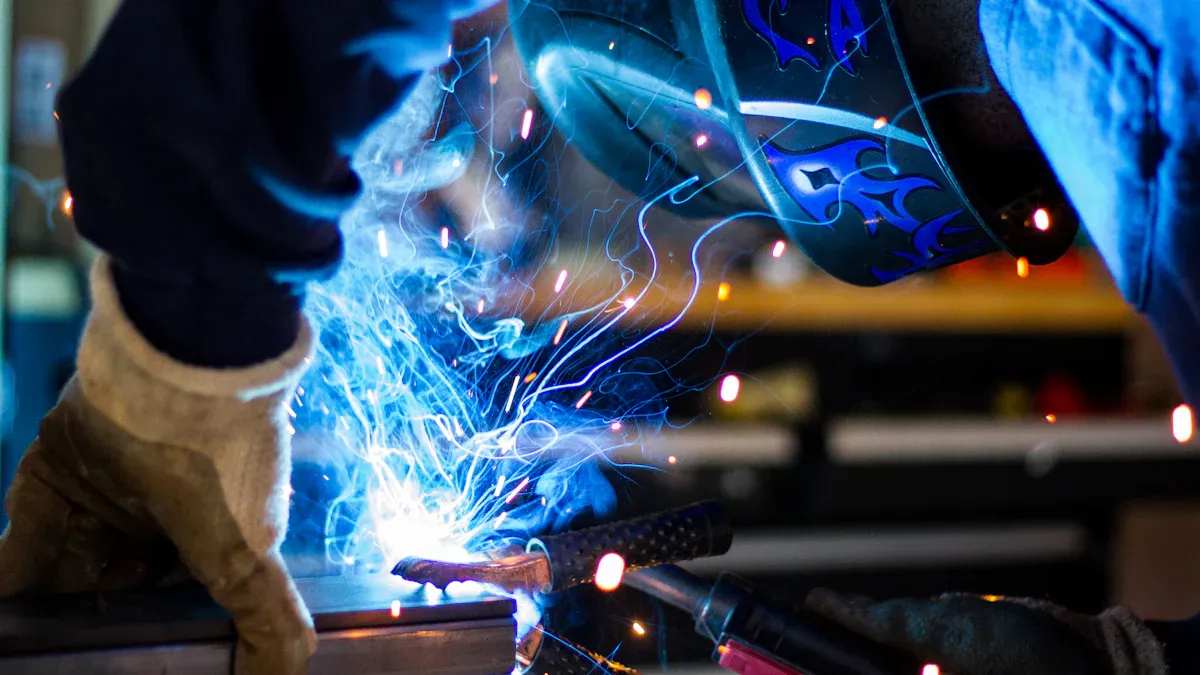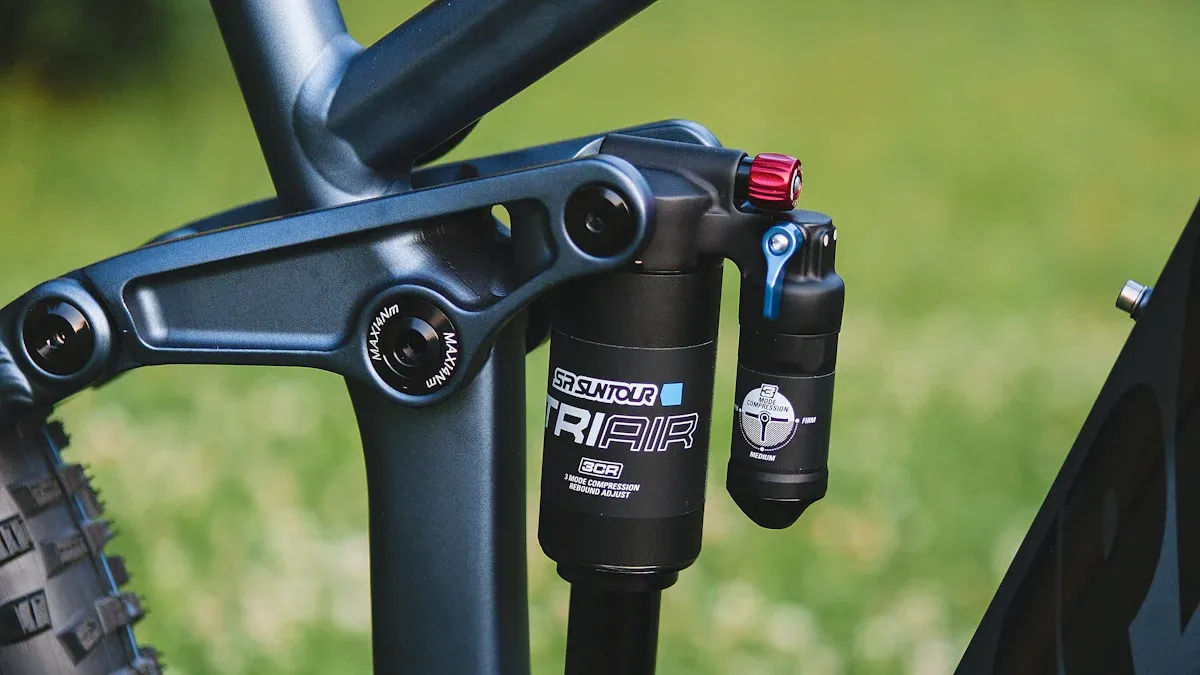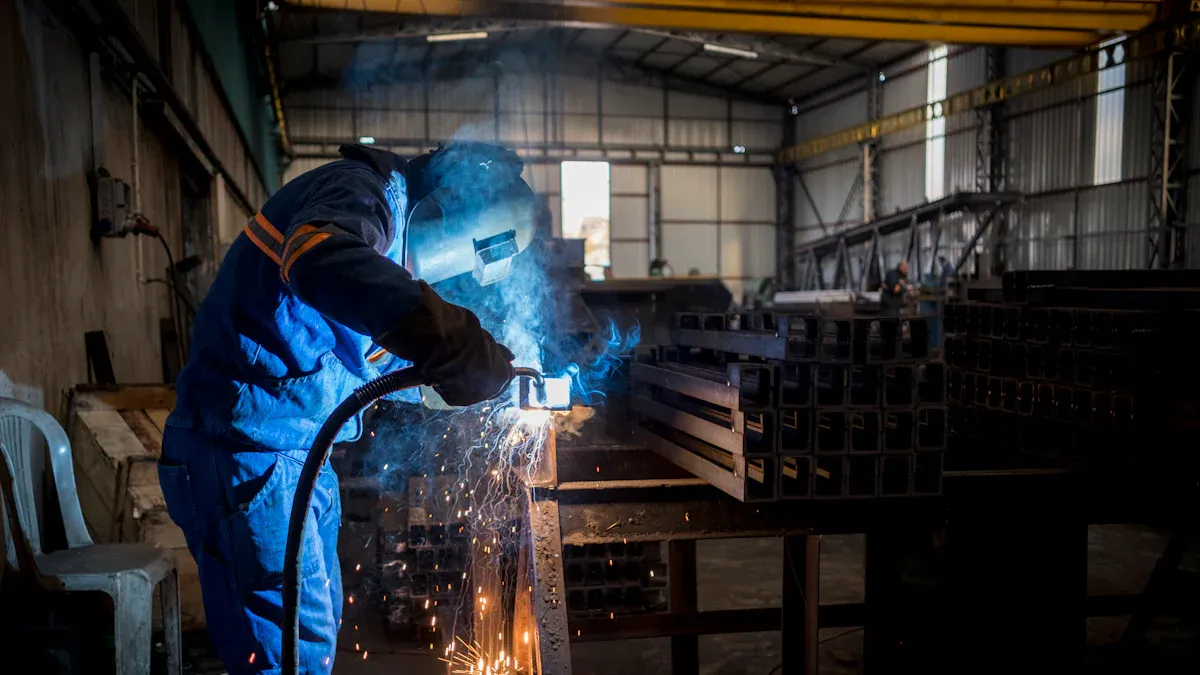
Choosing the right bike frame is very important, especially when considering options like steel bike frame welding. It affects how well you ride and how comfortable you feel. A good frame can significantly enhance your ride. Lugged and TIG welded frames have different features that cater to various types of riders. For example, lugged frames usually use steel, which is strong and lasts a long time, particularly when it comes to steel bike frame welding techniques. On the other hand, TIG welded frames often use aluminum, which is light and easy to handle.
Property | Aluminum Frames | Lugged Steel Frames |
|---|---|---|
~2.7 g/cc (about 1/3 the weight of steel) | ~7.85 g/cc (3 times heavier than aluminum) | |
Young’s Modulus | ~70 GPa (about 1/3 stiffness of steel) | ~200 GPa (3 times stiffer than aluminum) |
Resulting Weight | About 30% lighter | Heavier due to material density |
Knowing these differences in bike frames, including the benefits of steel bike frame welding, can help you choose the best one for your riding style.
Key Takeaways
Pick a lugged frame for comfort and stability. This is important for long rides. It handles bumps better and gives a smoother ride.
Choose a TIG welded frame if you want speed and efficiency. Its stiffness helps with power transfer. This makes it great for racing.
Think about how easy it is to repair the frame. Lugged frames are easier to fix. You can change broken tubes without needing to replace the whole frame.
Performance

Ride Quality
Lugged and TIG welded frames give different ride experiences. If you pick a lugged frame, you will likely have a smoother ride. The old steel bike frame welding method makes the frame more forgiving. This means it can handle bumps and rough roads better. You will feel more in touch with the road, which can make your ride better.
On the other hand, TIG welded frames are usually made of aluminum and feel stiffer. This stiffness helps with power transfer when you pedal. But it might not soak up vibrations like a lugged frame does. If you want speed and efficiency, a TIG welded frame could be better for you. But if comfort is what you want, a lugged frame is a good choice.
Handling
Handling is another important thing to think about. The shape and design of your bike affect how it feels on the road. Good weight balance and frame shape matching your body can really help. For example, the front-end shape, like head tube angle, fork rake, and trail, greatly affects bike handling.
Steeper head tube angles and less trail make handling quicker.
Slacker angles and more trail make it more stable.
A shallower head tube angle also increases stability, as does less fork offset.
With a lugged frame, you usually get a more relaxed shape, which can make for a stable ride, especially over long distances. This stability is great for touring or easy rides. In contrast, a TIG welded frame might have a more aggressive shape, making it better for racing or fast rides.
In the end, choosing between a lugged frame and a TIG welded frame depends on what you want from your ride. Do you like comfort and stability, or do you want speed and quickness?
Durability

Both lugged and TIG welded frames have good and bad points when it comes to durability. Knowing how they last can help you choose better.
Fatigue Resistance
Fatigue resistance is very important for bike frames. You want a frame that can take the stress of riding without breaking. Here’s how lugged and TIG welded frames stack up:
Steel’s Strength: Steel in lugged frames is very strong. It can handle many stress cycles without failing. This means you can ride longer without worrying about damage.
Aluminum’s Limitations: Aluminum frames, like those made with TIG welding, don’t last as long. They usually show fatigue after about 9-12 months.
Gradual Failure: Steel frames fail slowly. They give warning signs before breaking completely. This makes it safer for cyclists, letting you fix problems before they get worse.
Common places where bike frames fail include:
Weld points, especially where the top tube meets the seat tube and where the down tube connects to the bottom bracket.
Headtube junctions to the top and down tubes, which take on different loads.
The bottom bracket area, which gets a lot of stress during rides.
Repairability
Both frame types have good and bad sides when it comes to repairability. Here’s what you should know:
Strength and Reliability: Both lugged and TIG welded frames are strong if built well. But how easy they are to repair depends on the builder’s skills.
Common Concerns: Mechanics know that frames can break, which is a common worry. They say both types can be fixed, but the process is different.
Lugged Frames: Lugged frames are often easier to repair. The joints are usually easier to reach. If a lug fails, you can just replace that part without fixing the whole frame.
TIG Welded Frames: TIG welded frames can also be repaired, but it might be harder. Welded joints face dynamic loads, making them more likely to fail. If a weld breaks, it may need more work to fix.
Aesthetics
Visual Appeal
When we talk about looks, lugged frames often stand out. They have lugs that make strong joints and look interesting. Here are some design features that bike lovers enjoy about lugged frames:
Lugs can be shaped into artistic designs, making each frame special.
Simple painted lugs can give the bike character and charm.
New ideas in lug design have created more fun options, making them even more appealing.
On the other hand, TIG welded frames usually have a cleaner and simpler look. They might not be as eye-catching as lugged frames, but many riders still like their sleek style.
Customization
Customization choices are very different between lugged and TIG welded frames. Here’s a quick comparison:
Feature | Lugged Frames | TIG Welded Frames |
|---|---|---|
Aesthetics | Often seen as more visually appealing, especially with hand painting. | Usually less attractive, but can be customized. |
Manufacturing Cost | More expensive because of the lugs. | Cheaper, since welding costs less. |
Geometry | Limited by the design of the lugs. | More flexible in angles and shapes. |
Lugged frames let you add artistic details, showing off the skills of the builders. You can pick from many colors and designs, making your bike unique. In contrast, TIG welded frames allow for more changes in shape, so you can adjust the frame to fit your riding style. While they might not have the fancy designs of lugged frames, you can still customize them with different paint jobs and accessories.
In the end, whether you like the classic look of a lugged frame or the modern style of a TIG welded frame, both choices let you show off your style on two wheels.
Cost Comparison
Price Range
Lugged and TIG welded frames have different prices. Here’s a quick look at what you can expect:
Lugged Steel Vintage Bikes: Cost between $200 to $250.
Modern Lugged Frame Fixies: These usually cost around $1100.
TIG Welded Frames: These frames are often cheaper because they cost less to make.
Making a lugged steel frame costs much more than making a TIG welded frame. This difference usually shows in the price you pay.
Long-term Value
Knowing the long-term value of your bike frame is important. Here’s how the two types compare:
Welding Technique | Impact on Frame Value | Notes |
|---|---|---|
TIG Welding | Cheaper and faster method | Tubes are cut and put together in a jig before welding. |
Fillet Brazing | Makes smoother, nicer-looking joints | Higher-end builders like this method. |
Makes it easy to replace broken tubes | Adds less heat, keeping steel strong. |
Lugged frames usually offer better long-term value because they are easier to fix. If a tube gets damaged, you can just change that part without buying a whole new frame. This makes lugged frames a smart choice for those who want something that lasts. On the other hand, TIG welded frames are cheaper at first, but they might not keep their value as well over time, especially if they need repairs.
Custom vs Mass-Produced
When you think about bike frames, you have two main choices: custom and mass-produced. Each choice has its good points, so let’s look at them.
Custom Benefits
Custom lugged frames give you a special experience. You can adjust the fit to match your body, which makes riding more comfortable and helps you perform better. Finding the right mix of stiffness and comfort is very important. You want a frame that helps you pedal well while also softening bumps. Many cyclists feel that custom frames give them a ride that fits their needs. Also, if you need repairs, lugged frames are easier to fix. You can change broken tubes without needing to redo the whole frame. This is why they are popular with bike tourists who ride in faraway places.
Here are some key benefits of custom lugged frames:
Easier repairs because you can replace tubes.
Better fit made just for you.
Lightweight designs from lower brazing temperatures.
Mass-Produced Options
On the other hand, mass-produced frames are easy to find and usually cheaper. They come in many styles, including both lugged and TIG welded types. However, they might not give you the same level of personalization as custom frames.
Here’s a quick comparison of mass-produced frames:
Frame Type | Price Comparison | Construction Method |
|---|---|---|
Lugged Frames | Usually more expensive because of higher material costs and detailed work | Needs more detailed work and better materials |
TIG Welded Frames | Usually cheaper because of lower material costs and faster production | Less detailed, quicker to make, and no finishing time on welds |
Mass-produced frames can be a good choice if you want something that fits your budget. Just remember that you might lose some of the personalized fit and performance benefits that come with custom options.
Choosing between lugged and TIG welded bike frames depends on how you ride and what you like. Here’s a quick look at their good and bad points:
Frame Type | Strengths | Weaknesses |
|---|---|---|
Lugged | – You can change broken tubes without hurting others. |
Less heat used in building keeps it strong. | – Not as important with new air-hardened steel. | | TIG Welded | – Faster and cheaper to make.
Makes smooth and nice-looking joints. | – Steel frames can bend, which might change power transfer. |
Think about these tips based on your cycling needs:
If you like custom designs and comfort, choose a lugged frame.
For speed and efficiency, especially in races, a TIG welded frame could be best for you.
If you ride for fun or touring, a lugged frame gives you stability and is easy to fix.
In the end, your choice should match your riding style and what you care about most in a bike frame. Enjoy your ride! 🚴♂️
FAQ
What is the main difference between lugged and TIG welded frames?
Lugged frames have lugs for joints. TIG welded frames use welds to connect tubes. This changes how they ride and look.
Which frame type is better for long-distance riding?
Lugged frames are more comfortable and stable. This makes them better for long rides than stiffer TIG welded frames.
Can I repair both types of frames easily?
Yes, you can repair both frame types. But lugged frames are usually easier to fix because of how they are made.
See Also
Understanding Lugged Bike Frames: Construction and Features
Transitioning from Lugged Steel Frames in Mountain Biking
Comparing Carbon, Aluminum, And Steel Bike Frames for Consumers
